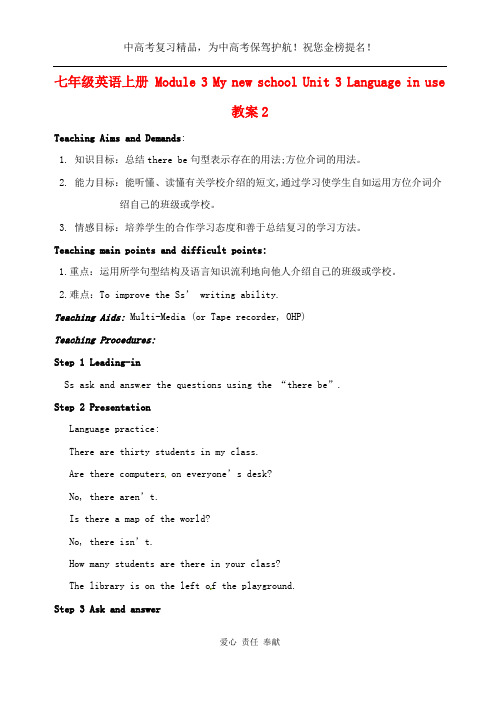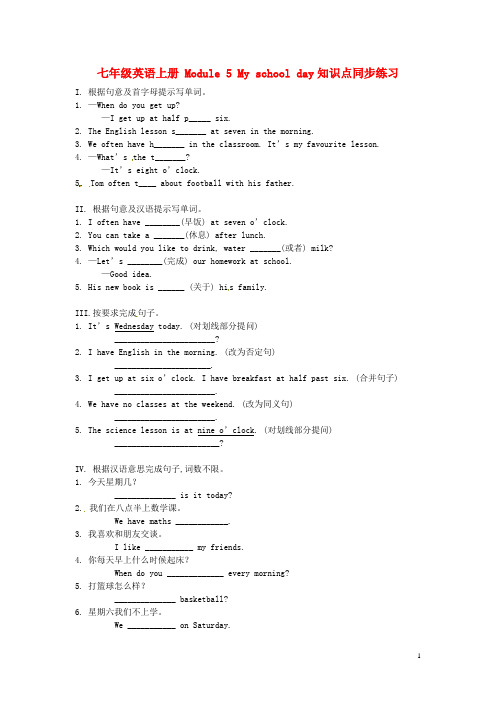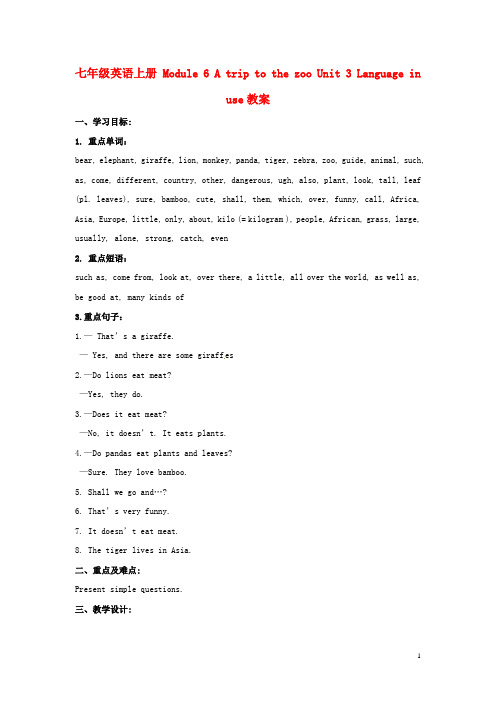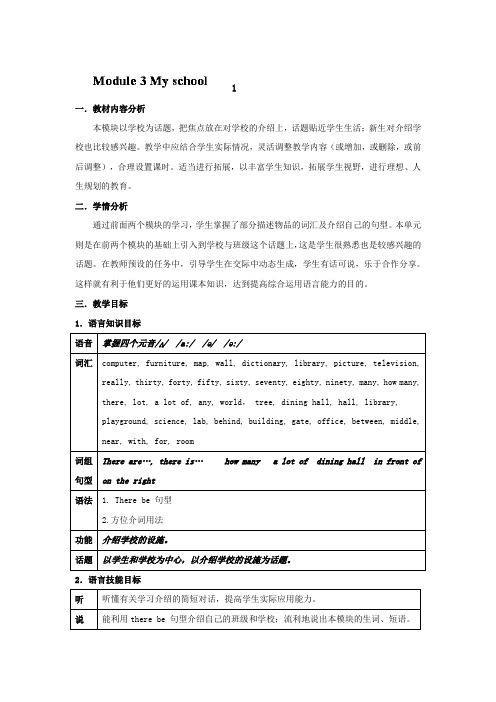广东省佛山市第十四中学七年级英语上册_Module_5_Unit_3_Language_in_use课件_(新版)外研版
- 格式:ppt
- 大小:760.00 KB
- 文档页数:29

七年级英语上册 Module 3 My new school Unit 3 Language in use教案2Teaching Aims and Demands:1. 知识目标:总结there be句型表示存在的用法;方位介词的用法。
2. 能力目标:能听懂、读懂有关学校介绍的短文,通过学习使学生自如运用方位介词介绍自己的班级或学校。
3. 情感目标:培养学生的合作学习态度和善于总结复习的学习方法。
Teaching main points and difficult points:1.重点:运用所学句型结构及语言知识流利地向他人介绍自己的班级或学校。
2.难点:To improve the Ss’ writing ability.Teaching Aids: Multi-Media (or Tape recorder, OHP)Teaching Procedures:Step 1 Leading-inSs ask and answ er the questions using the “there be”.Step 2 PresentationLanguage practice:There are thirty students in my class.Are there computers on everyone’s desk?No, there aren’t.Is there a map of the world?No, there isn’t.How many students are there in your class?The library is on the left o f the playground.Step 3 Ask and answerAsk and answer the questions about your school according to the pictures. Step 4 Look and answerLook at the pictures and answer the questions.1. Where is the off ice building?2. Where is the dining hall?3. Where is the playground?4. Where is the sports hall?5. Where is the science building?Step 5 Fill in the blanksRead the passage and fill in the blanks according to the picture.Step 6 Complete the mapLook at the word map and choo se the right places for the word and expressions from the box.blackboard, classroom, office, science hall, sports hallStep 7 Around the worldRead the passage about school age.Step 8 Draw a mapDraw a map of your school in a piece of paper.Step 9 Decide what to describe with the help of the words from the box book, classroom, computer, desk, library, office, playgroundStep 10 ProductionWrite a composit ion about your school.This is our school. There are …classrooms.This is our classroom. There are … students. There’s a(n) …,but there isn’t a(n) …Step 11 ExercisesStep 12 Hom ework请写一篇短文,介绍你的班级和学校。
![广东省佛山市第十四中学七年级英语上册_Module_6_A_trip_to_the_zoo_Unit_3_课件_(新版)外研版[1]](https://img.taocdn.com/s1/m/f59e5f212af90242a895e598.png)

Module 3 My new school测试题(2)一、单项填空(共15分,每小题1分)( )1. — Are there any dogs in your room?— ________.A. Yes, there isB. Yes, there isn’tC. No, there areD. No, there aren’t( )2. — Where is the gym?— _____.A. It is behind the libraryB. It is very bigC. We like doing sports in itD. There is an office in it( )3. How many days ________ in a week?A. there areB. are thereC. is thereD. there is ( )4. — Sir, do you know if there is a station over there?— ________, I am new here.A. Excuse meB. SorryC. OKD. Certainly ( )5. There ________ a factory and two hospitals in the town.A. haveB. areC. isD. has( )6. _________are my parents. _________ work in an office.A. These; TheyB. This; HeC. They; ItD. That; They ( )7.A bus station is between the school ____ the farm.A. butB. andC. nearD. behind( )8.— What is ____ your desk?— It is an I Pad 2. I like playing puter games.A. inB. onC. atD. under( )9.— Is the desk in front of Daming?—No, _______ isn’t.A. itB. heC. sheD. there( )10. — Are there ____ puters in your classroom?—No. There aren’t ___ puters in our classroom.A. some; someB. any; anyC. some; anyD. any; some( )11. — Is there a desk in the classroom?— No, _______.A. it isB. it isn’tC. there isD. there isn’t( )12. Daming and Lingling are students. ______ English teacher is Mr White.A. TheirB. TheyC. OurD. We( )13. Eighteen, _______, twenty. OK. There are twenty students in the classroom.A. seventeenB. seventyC. nineteenD. ninety( )14. — Is there a photo in _______ office?— Yes, there is.A. Mr LiB. Mr Li isC. Mr LisD. Mr Li’s( )15. _________ a cat, a dog and a bike next to the table.A. There areB. It’sC. There isD. There aren’t二、完形填空(共10分,每小题0.5分)(1)This is Daming. He is 16 good friend. I like playing with him. He is 17 the city, 18 now he is in the countryside (乡村) 19 his parents. His house is20 a river. It’s not a tall 21 . There are three22 in his house. In front of the house, 23 are some flowers. There are some trees behind his house. This is his room. In it there 24 a bed and a desk.He can 25 his homework on the desk. He likes his new house.( )16. A. your B. myC. his D. her( )17. A. to B. behindC. from D. front( )18. A. but B. andC. or D. then( )19. A. in B. onC. at D. with( )20. A. of B. inC. under D. next to( )21. A. building B. classroomC. office D. library( )22. A. schools B. roomsC. hotels D. doctors( )23. A. here B. thereC. these D. those( )24. A. am B. areC. is D. be( )25. A. play B. rideC. do D. speak(2)阅读文章内容,在空白处填上适当的词(每空一词),使文章语言通顺内容完整Do you like reading? Do you have your own (自己的) reading time? Many people often say 26_________ this, “I have 27_________ time to read. I have 28_________ work to do every day.” We usually have some time 29_________readin g at school. 30_________ I have my own quiet reading time 31__________ home. Before I go to 32_________, I get ready to read, I look at the 33_________ and begin to read for fifteen minutes. Then I 34__________ off the light and go to sleep. I 35__________ 105 reading minutes at home each week.三、阅读理解(共10分, A 篇每小题1分; B篇每小题2分)AHello, my name is Mike. I am from England. I am a new student in JasonSchool. I am in Class 2, Grade 1. I go to school 5 days a week and there are 6 classes a day. There are 25 students in my class. I am very happy to meet them. English is my favorite lesson. Miss Green is my English teacher. She is 27 years old. I like having her class. There is a puter in my classroom. Miss Green likes playing English songs on the puter in her class and we like these songs. Now I can sing many English songs. There are some pictures in the classroom because some students like drawing pictures and they draw very well. I like my classroom and my new school. Wele to my school! ( )36. Mike is a ____ in JasonSchool.A. studentB. teacherC. doctorD. worker( )37. How many classes are there in the school a day?A. Five.B. Six.C. Seven.D. Eight.( )38. There are ____ students in Mike’s class.A. 5B. 6C. 25D. 27( )39. What can we see in Mike’s classroom?A. A map.B. Some flowers.C. A television.D. Some pictures.BThere are over 800 boarding (寄宿) schools in the UK with students from home and foreign countries. Boarding schools started hundreds of years ago in the country. But the earliest boarding schools were set up for white, rich boys only. Now both boys and girls can go to boarding schools from the age of 7 to 18.What to doIn the UK, boarding schools have three terms in a school year, with about 13 weeks in each term. Students study and live together. They can’t go outside if they are not allowed to. In some schools, each student has his or her subject plan. Besides the usual classrooms and laboratories, the boarding schools have lots of other facilities for their students, including music rooms, boats, swimming pools, cinemas and theatres. Most boarding schools have a “light out” time. So when it’s time to go to bed, all the lights in the bedrooms are turned off. There are house-masters to take care of students all the time, especially after school hours.What to wearNearly all students at boarding schools wear a school uniform. Boys usually wear a shirt and a tie, and girls wear a white blouse, sometimes also a tie and a skirt. As students get older, the rules bee less strict.____________In the UK, boarding schools provide students with delicious food. They can choose to have a full English breakfast or simply bread. They can also choose between a meal with no meat and another meal at lunch and dinner. And there is always self-service for salad (沙拉), other side dishes and a dessert. Students can also make themselves something to eat at any time in a kitchen, or drink tea or have a snack between meals.( ) 40. Which of the following is TRUE according to (根据) the passage?A. Only white children were allowed to attend the earliest boarding schools.B. Students in a boarding school are looked after only after school hours.C. As students get older, the rules about wearing school uniforms beestricter.D. Students can have different activities in a boarding school.( ) 41. Which is the best title for the last paragraph?A. What to eatB. When to eatC. Where to eatD. How to eat( ) 42. The underlined word ‘facilities ’ in the passage means _____________.A.教师B. 设施C. 活动D. 课程四、词汇检测(共10分)A. 根据短文内容,用方框内所给词的正确形式填空,每空一词。

七年级英语上册 Module 5 My school day知识点同步练习I. 根据句意及首字母提示写单词。
1. —When do you get up?—I get up at half p_____ six.2. The English lesson s_______ at seven in the morning.3. We often have h_______ in the classroom. It’s my favourite lesson.4. —What’s the t_______?—It’s eight o’clock.5. Tom often t____ about football with his father.II. 根据句意及汉语提示写单词。
1. I often have ________(早饭) at seven o’clock.2. You can take a _______(休息) after lunch.3. Which would you like to drink, water _______(或者) milk?4. —Let’s ________(完成) our homework at school.—Good idea.5. His new book is ______ (关于) hi s family.III.按要求完成句子。
1. It’s Wednesday today. (对划线部分提问)_______________________?2. I have English in the morning. (改为否定句)______________________.3. I get up at six o’clock. I have breakfast at half past six. (合并句子)_______________________.4. We have no classes at the weekend. (改为同义句)_______________________.5. The science lesson is at nine o’clock. (对划线部分提问)________________________?IV. 根据汉语意思完成句子,词数不限。

七年级英语上册 Module 6 A trip to the zoo Unit 3 Language inuse教案一、学习目标:1. 重点单词:bear, elephant, giraffe, lion, monkey, panda, tiger, zebra, zoo, guide, animal, such, as, come, different, country, other, dangerous, ugh, also, plant, look, tall, leaf (pl. leaves), sure, bamboo, cute, shall, them, which, over, funny, call, Africa, Asia, Europe, little, only, about, kilo (= kilogram ), people, African, grass, large, usually, alone, strong, catch, even2. 重点短语:such as, come from, look at, over there, a little, all over the world, as well as, be good at, many kinds of3.重点句子:1.— That’s a giraffe.— Yes, and there are some giraff es2.—Do lions eat meat?—Yes, they do.3.—Does it eat meat?—No, it doesn’t. It eats plants.4.—Do pandas eat plants and leaves?—Sure. They love bamboo.5. Shall we go and…?6. That’s very funny.7. It doesn’t eat meat.8. The tiger lives in Asia.二、重点及难点:Present simple questions.三、教学设计:Unit 3 Language in useⅠTeaching modelRevision and appli cationⅡTeaching methodFormal and interactive practiceⅢTeaching aims1. To summaries and consolidate Present simple questions.2. To know something about animals in China.3. To have teamwork and make a poster of one’s favourite animal.ⅣTeaching ObjectivesKey structures: It doesn’t eat meat.The tiger lives in Asia.Does it eat meat?No, it doesn’t. It eats plants.ⅤTeaching aidsTape recorder, OHP, handoutsⅥTeaching StepsStep 1 RevisionShow some pictures to review the text of Unit 1 and Unit 2.Step 2 Language practice1. Read through the example sentences in the box with the whole class.2. Ask the students to repeat the sentences in the box.3. Grammar: The present simpleStep 3 Work in pairs1. Look at the pictures. Ask: What can you see?2. Ask and answer with a partner.4. Call back the answers from the whole class, check the answers.Keys:1. —Does Meimei the elephant come from Yuannan, China?—Yes, it does.2. —Does Kingba the tiger come America?—No, it doesn’t. It comes from Asia.Step 4 Complete the sentences with does or doesn’t.1. Read through the sentences with the whole class.2. Ask the students to complete the sentences with a partner.3. Call back the answers from the whole class, check the answers.Keys:1. Does, does2. Does, doesn’t3. Does, does4. Does, doesn’t5. doesn’t Step 5 Complete the passage with the correct form of the words in t he brackets.1. Read through the passage with the whole class.2. Ask the students to fill in the blank individually, then check with a partner.3. Call back the answers from the whole class, check the answers.4. Read the passage together loudly.Keys :1. are2. is3. is4. doesn’t5. comes6. eatsStep 6 Complete the word map with the words from the box.1. Read through the words in the box with the whole class.2. Ask the students to complete the word map with the words from the box with a partner.3. Call back the answers from the whole class, check the answers.Step 7 Around the world:1. Ask the students to look at the picture and discuss what they can see.2. Read thro ugh the information with the whole class, and talk something about them. Step 8 Module task: Making a poster of your favourite animal.1. Work in groups.1) Find out about an animal.2) Talk about your favourite animal.3) Choose on e animal to write about4) Find out about the animalIt’s big/ small / tall, black and white /…It come from Asia / Africa /…It eats meat / grass/ bamboo/…2. Make a poster about your group’s animal.1) Draw it or find a photo.2) Write some information about it.3. Present your poster to the class.Step 9 Important and difficult points.行为动词一般现在时的疑问式和回答一般现在时的疑问式在句首加助动词do, 主语为第三人称单数时在句首加does,其结构是:1.Do + 主语+ 动词原形…?They live near our school.Do they live near our school?The students like learning English.Do the students like learning English?2.Does + 主语(第三人称单数)+ 动词原形…?He watches TV every evening.Does he watch TV every evening?My father teaches Chinese.Does your father teach Chinese?3.简略回答用助动词do / does 和don’t / doesn’t 代替行为动词。

l一.教材内容分析本模块以学校为话题,把焦点放在对学校的介绍上,话题贴近学生生活;新生对介绍学校也比较感兴趣。
教学中应结合学生实际情况,灵活调整教学内容(或增加,或删除,或前后调整),合理设置课时。
适当进行拓展,以丰富学生知识,拓展学生视野,进行理想、人生规划的教育。
二.学情分析通过前面两个模块的学习,学生掌握了部分描述物品的词汇及介绍自己的句型。
本单元则是在前两个模块的基础上引入到学校与班级这个话题上,这是学生很熟悉也是较感兴趣的话题。
在教师预设的任务中,引导学生在交际中动态生成,学生有话可说,乐于合作分享。
这样就有利于他们更好的运用课本知识,达到提高综合运用语言能力的目的。
三.教学目标1.语言知识目标语音掌握四个元音/ʌ/ /a:/ /ə/ /ə:/词汇computer, furniture, map, wall, dictionary, library, picture, television, really, thirty, forty, fifty, sixty, seventy, eighty, ninety, many, how many, there, lot, a lot of, any, world, tree, dining hall, hall, library,playground, science, lab, behind, building, gate, office, between, middle, near, with, for, room词组句型There are…, there is… how many a lot of dining hall in front of on the right语法 1. There be 句型2.方位介词用法功能介绍学校的设施。
话题以学生和学校为中心,以介绍学校的设施为话题。
2.语言技能目标听听懂有关学习介绍的简短对话,提高学生实际应用能力。
七年级英语上册 Module 3 My new school Unit 2 同步练习◆I. 从B栏中找出同A栏相对应的数字。
A B( ) 1. Forty-two. a. 96.( ) 2. Seventy. b. 57.( ) 3. Ninety-six. c. 30.( ) 4. Twenty. d. 42.( ) 5. Fifty-seven. e. 80.( ) 6. Thirty. f. 70.( ) 7. Sixteen. g. 20.( ) 8. Nineteen. h. 19.( ) 9. Eighty. i. 16.( ) 10. Fifteen. j. 15.◆II. 将下列各句改为否定句。
1. There are 20 doctors in the hospital.______________________2. There is a school next to the library.______________________3. There is some milk in the bottle.______________________4. There are some students in the classroom.______________________◆III. 将下列各句改为疑问句。
1. There is a pen on the table.______________________2. There are three libraries in the city.______________________3. There is a basketball near the chair.______________________4. There are some hotels next to the hospital. ______________________5. There is a shop in front of the building.______________________参考答案I. 1-5 dfagb 6-10 cihejII.1. There are not 20 doctors in the hospital.2. There is not a school next to the library.3. There is not any milk in the bottle.4. There are not any students in the classroom. III.1. Is there a pen on the table?2. Are there three libraries in the city?3. Is there a basketball near the cha ir?4. Are there any hotels next t o the hospital?5. Is there a shop in front of the building?。
Module 5 My school day自测题(1)听力部分(20分)(省略)基础训练 (25分)I. 词汇 (每小题1分,共10分)A) 根据汉语提示填写单词。
21. We have _____________ (地理 at 10:30.22. It’s 10:00. Would you like to have a _______ (休息)?23. There are many ____________ (房子) in front of my school.24. Let’s _____________ (谈论) about our plan for Sunday.25. — Can we play football in the ______ (公园)?—No, you can’t.B) 根据首字母提示填写单词。
26. 7:30 is h__________ past seven.27. Lessons start at 9:00 and f_________ at 17:00.28. —What’s the t____________?—It’s 11:00.29. I like drawing. My favourite lesson is a_________.30. On Sunday morning I help (帮助) my parents do h____________ at home. II. 单项选择(每小题1分,共15分)( )31. It’s 7:30 in the morning. Let’s have ________.A. breakfastB. a breakfastC. dinnerD. the lunch( )32. They go to the cinema ______ six o’clock ______ Saturday evening.A. in; onB. on; inC. at; onD. to; in( )33. — __________ is your swimming lesson?— In the afternoon.A. WhereB. WhenC. WhatD. Who( )34. Daming and Lingling ____________ go to school on Saturday.A. don’tB. aren’tC. noD. not( )35. They watch TV at 20:00 __________ go to bed at 21:00.A. butB. orC. /D. and( )36. Tony and I ___________ an English lesson in the afternoon.A. doB. goC. haveD. invite( )37. — What time is it?—It’s _____________.A. three o’clockB. three thirtyC. thirty to threeD. six fifteen( )38. —I’m 13 years old. ______________?— 14.A. Ho w are youB. Where are you fromC. What’s your nameD. What about you( )39. Maths _________ at 10:00 in the morning.A. amB. isC. areD. be( )40. It’s five o’clock in the afternoon. Let’s ______________.A. to go homeB. to go to homeC. go homeD. go to home( )41. We study something about Qing Shihuang from our _____________ lesson.A. historyB. musicC. scienceD. maths( )42. They love Chinese. It’s their _____ lesson.A. goodB. happyC. rightD. favourite( )43. — What day is it today?— ________________.A. It’s threeB. It’s in the even ingC. It’s fineD. It’s Wednesday( )44. I’m Miss Wang. I often (常常) talk ______ my students at my office. A. in B. toC. ofD. on( )45. I have Chinese and English today. I love _____________.A. themB. himC. herD. it提高发展 (30分)III. 完形填空(每小题1分,共10分)Hi! I’m Daming. My school is 46 and nice. I go to school 47 days a week - from Monday to Friday. I have got seven 48 a day. There are four in the morning and 49 in the afternoon. Lessons 50 at 8:30 in the morning. There are forty-five minutes (分钟) in every class. Today I have English at half 51 eight. I have maths at 9:25 and I 52 history at 10:30. History is my favourite lesson. I like 53 . I have music at 11:25.In the afternoon, I have two Chinese lessons. And I have 54 art lesson at 4:20. Lessons finish at 5:05. I go home and have 55 with my parents. Then (然后) I do my homework.( )46. A. cold B. big C. fat D. healthy( )47. A. two B. seven C. four D. five( )48. A. lessons B. friends C. classrooms D. schools( )49. A. two B. three C. five D. six( )50. A. finish B. live C. close D. start( )51. A. past B. to C. in D. on( )52. A. come B. go C. have D. eat( )53. A. its B. it C. them D. their( )54. A. a B. an C. the D. /( )55. A. breakfast B. lunch C. dinner D. the dinn erIV. 阅读理解(每小题2分,共20分)Acomputer( )56. There are ________ subjects (科目) for the students in a week.A. sevenB. eightC. nineD. eleven( )57. The students have music on _____.A. Monday and FridayB. TuesdayC. Tuesday and ThursdayD. Wednesday( )58. The students have ______ Chinese lessons every week.A. 3B. 4C. 5D. 6( )59. The students have their first lesson at ______________.A. 8:00B. 9:00C. 10:20D. 11:20( )60. Which is NOT true?A. The students have four lessons in the morning.B. The students have physics on Wednesday.C. The students don’t have science on Friday.D. The lessons in the morning finish at twelve o’clock.BIn my city, people have breakfast around (大约) seven. We drink warm tea or milk in the morning. Many people have some bread, eggs or hamburgers.Around noon it is the lunchtime. Many people take (带) their food to schools or their work-places. Some people like going to a restaurant (饭店) or having fast food in a McDonald’s. But I think these foods are unhealthy. We can have some meat with some vegetables or rice. Healthy fish slowly (慢慢地)replaces beef and pork. It’s healthy to drink one glass of water or juice after lunch.At six or seven in the evening, it’s time for dinner. At this time, families get together. We often have warm food. Sometimes we go to restaurants to eat. ( )61. Many people _______ for lunch according to the passage.A. have fast foodB. go to restaurantsC. take their foodD. drink cold tea or milk( )62. The word “replace” means “_________” in Chinese.A. 变成B. 代替C. 吸引D. 损害( )63. Which is RIGHT according to the passage?A. We should have a big breakfast.B. We cannot have some meat with rice.C. Food in McDonald’s is good.D. People usually (通常) have dinner at home.( )64. The writer tells us __________.A. what drink is healthyB. how to eat in restaurantsC. what to eat in his / her cityD. where to have breakfast( )65. Where can we read this passage?A. On a map.B. In a song.C. In a dictionary.D. In a book.综合运用 (25分)V. 情景交际(每小题1分,共5分)根据上下文,填写句子,使对话内容完整、语义连贯。